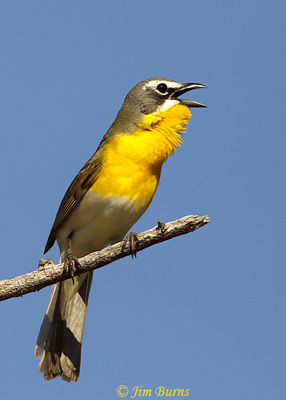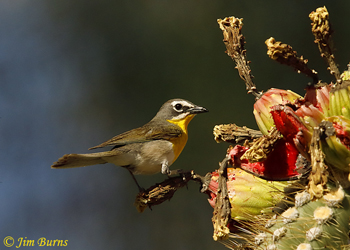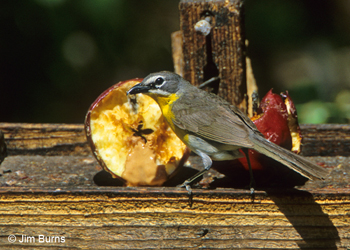
Imagine, then, the consternation of a beginning birder who, having heard and then luckily caught a glimpse of Yellow-breasted Chat, finally finds it in their guide book also placed at the end of the wood warblers, a family with which on close inspection it bears little resemblance—considerably larger with a different body shape, a totally different bill, and don’t get me started on the song, because I will not allow you to call chat vocalizations a “song” or mention them in the same sentence with “warble.”
Originally placed with the wood warblers, Parulidae, despite the obvious visual and vocal differences with that family, DNA research has now proven Yellow-breasted Chat was probably a singular offshoot from the genetic branch which produced wood warblers, sparrows, and Icterids, the blackbirds and orioles. If you’ve ever been fortunate enough to have entered what I call Chat World, you know what a unique species this is.
A large part of the chat mystique revolves around how difficult they are to find and actually see well, this despite the fact that they are very vocal on the breeding ground and those vocalizations are loud, unique, and unforgettable, often repeated for minutes on end from several different high perches, in dense foliage, which you cannot find to save your soul. I recently hiked through a park, up a wash on one side of a ridge, then down through a riparian canyon on the other side, and identified by ear six different chat territories. Do I need to tell you I never saw a single chat?
It often occurs to me that Yellow-breasted Chat may be the most aptly named bird in North America. There is the stunning yellow breast of course, occasionally intense molten orange on a “singing” male in spring, but whence came the “chat” part? Perhaps it derived from the old English name for stonechat because its harsh calls sounded like stones being clicked together and reminded North American colonists of the bird they’d left behind. Or maybe it’s simply a play on the word “chatterbox.” Indeed, here is my favorite description of its repertoire, one I wish I had written—
An amazing conglomeration of whistles, squeaks, squeals, musical single notes and phrases, and harsh chattering in varied sequence and timing, poured out in unpremeditated artlessness. The early ornithologist who penned that description claimed he had heard in it the “rasp of a kingfisher, trill of a tree toad, call of a yellowlegs, and distant auto horn.”
Entry into Chat World, then, is fraught with frustration, vocals without visuals, scolding which sounds like laughter, bushes with no birds, leaves moving where one just left, and silence where there was cacophony before you took that last step. Funny thing is, you don’t need a tape because all of the birds’ vast variety of gurgles and grunts are easily mimicked. One of the calls, the one that sounds like a spring to me, a one syllable oiiing, is very much ventriloquial. It sounds like the bird is right above, one step away, while every other note in the repertoire sounds three trees away. But, if you take that one step? Silence, because it’s gone. Trust me on this one.
Chats are said to be uncommon, yet they are known to sometimes nest in loose colonies. Chats are reputed to be secretive. Yeah, they got that right! They nest in dense vegetative tangles, often in briar thickets or margins of swamps. Some have suggested the best way to spot one is to listen for a spring male “singing” (female Yellow-breasted Chats do not vocalize), sit down in its territory, and wait in silence. Don’t try this if you’re allergic to ant bites, easily bored, or don’t like the sound of silence.
I’ve heard chats called “colorful mockingbirds” because some of their harsh vocals sound similar to that other, most conspicuous of species and, on occasion in spring, a chat may unexpectedly burst upward from a leaf shrouded canopy “singing” post, spread its wings, and flutter downward while calling, an uncommon display most likely announcing territory to a nearby female. We’ve all seen mockingbirds display like this. Chats, not so much. How lucky can you get to see that display by this species?
The chat diet is about half insects, half fruits and berries. I’ve seen them in spring on Saguaro fruit right along with the doves and woodpeckers, and I’ve seen them in late summer on a fruit board at a viewing station eating apples spread with peanut butter. I’ve also spooked them from both live greenery and dead leaf litter on the forest floor where they were undoubtedly prospecting for ants, spiders, beetles, etc.
I was years into birding before I got my first really good look at a chat. I was decades into bird photography before I got any decent shots, and it was only this past spring that I finally persevered (notice I didn’t say “lucked” because it’s just spending enough time in their territory) into the shot I’d always envisioned, the header for today’s column.
I had somehow entered Chat World without realizing it. Sloshing down a desert wash in ankle deep water, I heard a distant chat. He gurgled. I gurgled back, really just for the deviltry of it. He chattered, sounding a lot like a Hooded Oriole. I chattered back, hoping I sounded a lot like a chat and not a Hooded Oriole. It was a fairly open wash, just the snag in front of me, sunrise behind me. He whistled. I whistled back. Then silence. I shrugged to myself. He wasn’t interested, so I picked up the tripod and prepared to keep on sloshing.
And then caught my breath as he suddenly swept up the wash from god-knows-where, landed atop the highest perch on the snag, and began to let this interloper know whose territory it was. Sometimes the key to Chat World is simply finding the right bird at the right time, just one of many inexplicable goings on in that world.
|
|

